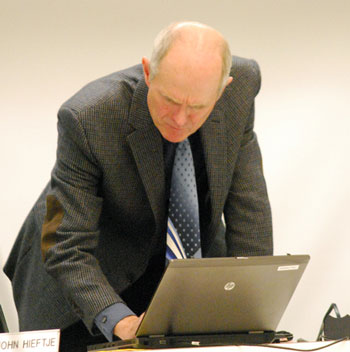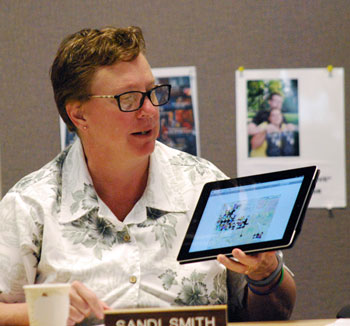Sundance Film Festival banners going up on light posts. [photo]
Stories indexed with the term ‘light poles’
Ann Arbor Grinds Gears But OKs Rail Study
Ann Arbor city council meeting (Oct. 21, 2013): The council did not adjourn its meeting until just before 1 a.m., but still left itself with unfinished business.

Mayor John Hieftje checked his computer screen before the meeting started. Six hours later he declared the meeting adjourned. (Photos by the writer.)
Some of that business – the Ann Arbor Downtown Development Authority ordinance revision on TIF (tax increment financing) capture – was postponed until the council’s next meeting, on Nov. 7. Other business – Ypsilanti Township’s membership in the AAATA – was postponed until Nov. 18. That will be the first meeting of the new, post-election composition of the council.
First, here’s a rundown of the main outcomes from the meeting.
Transportation was a main theme on the agenda. The postponement on admitting Ypsilanti Township as a member of the Ann Arbor Area Transportation Authority was the clear majority consensus, as it succeeded on an 8-3 vote. After that, the council voted unanimously to approve a contract with URS Corporation Inc. (URS) to conduct the Ann Arbor Station project environmental review. The total approved for the Ann Arbor Station contract – which will cover public engagement, site selection and conceptual design – was $824,875, an amount that includes a $63,083 contingency.
The city would pay 20% of that, or about $165,000. The remainder will be covered by a federal grant. The council’s unanimous support was based on two factors: (1) the fact that there was to be no presupposed preferred alternative location for the station, and (2) that the public engagement process outlined in the project tasks was thorough.
The council also voted unanimously to give final approval to a change in the city’s sidewalk ordinance. As a result, cross-lot walkways in Ann Arbor will now be treated as “sidewalks” from the perspective of the city’s sidewalk repair millage. Even though the millage funds can now be used to repair the walkways, owners of property adjacent to cross-lot walkways will not bear responsibility for snow removal in the winter. Cross-lot walkways include those that connect streets to parks or school property, or connect two parallel streets.
The Ann Arbor DDA figured in other agenda items beyond the postponed vote on TIF capture. The council voted just 7-4 to approve a new budget allocation of $280,000 from the general fund to pay for a portion of a Main Street light pole replacement project. That didn’t meet the eight-vote majority requirement for the budget allocation to pass. The failed vote was the result of political wrangling between the council and the DDA board and staff over whether the DDA would not be able, or simply was unwilling, to fund the total cost of the $580,000 light pole replacement project. The poles are rusting out and pose some level of safety threat, although those deemed to be in immediate danger of falling have already been replaced.
The Ann Arbor DDA was also the topic of another agenda item – when the council voted 8-3 to reconsider its Sept. 16 vote on the appointment of Al McWilliams to the board of the DDA. On the 8-3 vote, the question of the appointment was again in front of the council. Councilmembers took 20 minutes to discuss the item before voting again 6-5 – along the same split as on Sept. 16 – to appoint McWilliams to the board. The 8-3 split on reconsideration was the same 8-3 split as on the postponement of the Ypsilanti Township membership in the AAATA – with mayor John Hieftje, Christopher Taylor (Ward 3) and Margie Teall (Ward 4) declining to join the majority on both occasions.
The other nomination on which the council voted was Wayne Appleyard’s reappointment to the city’s energy commission – with a tally of 8-3. That was enough to satisfy the city charter’s non-city resident requirement of seven votes. Dissenters were Mike Anglin (Ward 5), Sumi Kailasapathy (Ward 1) and Jane Lumm (Ward 2). Kailasapathy and Lumm had concerns about Appleyard’s long term of service (since 2002). So they’ll be bringing forward an ordinance revision at a future meeting to establish term limits for all boards and commissions. The city charter already imposes term limits on a specific category of boards and commissions.
The council had another significant item on its agenda related to the energy commission – a resolution on divestment from fossil fuel companies that the commission had recommended the council approve. It was the third time the council had seen the question, after first voting it down, then reconsidering and postponing it. At the Oct. 21 meeting, the council amended the resolution to soften it further, which gave it a 9-2 tally when the council voted. Ward 2 councilmembers Sally Petersen and Jane Lumm dissented.
Besides the unfinished business from the Oct. 21 meeting, future meetings of the council will include the Lumm-Kailasapathy initiative to amend the city’s ordinance on boards and commissions to include term limits. Other initiatives announced at the Oct. 21 meeting included an outdoor smoking ordinance that Chuck Warpehoski (Ward 5) reported he’s been working on with city staff – with an eye toward establishing non-smoking areas in city parks.
Petersen announced that she’ll be putting forward a resolution stemming from frequent mention by community members of the need for a council ethics policy. Among other direction, Petersen’s resolution would ask the city attorney to provide guidance on a state statute. Warpehoski announced that he and Sabra Briere (Ward 1) were working on a framework to establish a pedestrian safety citizens advisory committee – possibly to be seated at the Nov. 18 council meeting. The effort is not designed to determine or preempt the outcome of an effort to repeal the pedestrian crosswalk ordinance, Warpehoski stated.
And Christopher Taylor (Ward 3) announced that he and Margie Teall (Ward 4) would be bringing forth a resolution asking the University of Michigan to decommission the large digital billboard it has constructed on East Stadium Boulevard next to the football stadium. The fallback position of the resolution will be to ask that the university restrict the time of the billboard’s operation, Taylor said.
Some items considered by the council but not included in this report are reflected in the live updates filed from the Oct. 21 meeting. [Full Story]
Oct. 21, 2013 Ann Arbor Council: Final
The Oct. 21, 2013 meeting of the Ann Arbor city council is the last one before the Nov. 5 election. After the election, the current group of councilmembers will have just one more meeting, on Nov. 7, before the new council is seated. The agenda the current council faces on Oct. 21 is relatively heavy.

The sign on the door to the Ann Arbor city council chamber, installed in the summer of 2013, includes Braille.
It’s possible that the council might be briefed at the meeting on proposals received by the Oct. 18 deadline for the purchase of the city-owned parcel on William Street between Fourth and Fifth avenues (the former Y lot), but that’s not yet clear. The property had been listed for $4.2 million.
Many of the Oct. 21 items already on the agenda can be divided into three main categories: transportation, the Ann Arbor Downtown Development Authority, and the city’s energy commission.
The council held a work session about transportation on Oct. 14, 2013. Transportation-related items on the Oct. 21 agenda include a resolution that would admit Ypsilanti Township as a member of the Ann Arbor Area Transportation Authority. The specific question to be considered is a revision to the AAATA’s articles of incorporation – which would also expand the number of board members from nine to 10.
A second transportation-related agenda item is a city-led initiative to develop a new train station, with the location to be determined. The existing location, as well as one on Fuller Road near the University of Michigan medical campus, would be among the possibilities. On the council’s agenda is a contract with URS Corp. to conduct an environmental review that would include public engagement, site selection and conceptual design. The council’s authorization would be $824,875, an amount that includes a $63,083 contingency. The city would pay 20% of that, or about $165,000, with the rest covered by a federal grant that has already been awarded by the Federal Rail Authority.
To the extent that pedestrian infrastructure is also part of the city’s transportation system, a transportation-related pair of items would alter the definition of “sidewalk” to include cross-lot walkways. Affected by the change, for example, would be walkways that connect streets with parks or school property. The change would allow for use of sidewalk repair millage funds to repair cross-lot walkways, without triggering the winter maintenance requirement for adjacent property owners.
Finally, the city council will be asked to approve an annual resolution related to wintertime transportation – the purchase of ice control salt for city streets.
Related to the Ann Arbor DDA are three items: (1) reconsideration of the appointment of Al McWilliams to the board of that authority – likely to be confirmed on a re-vote, if reconsideration is approved; (2) final consideration of a change to the city ordinance regulating the DDA’s TIF (tax increment financing) capture – likely to be postponed yet again; and (3) a budget allocation of $280,000 to cover costs associated with replacement of downtown ornamental, pedestrian-scale light poles. The DDA is contributing $300,000 to the cost of the $580,000 project. Some councilmembers think the DDA should pay for the full amount, so the eight-vote majority required for the budget amendment might not be achieved.
The specific size of the majority vote required could also be a factor in one of two agenda items related to the city’s energy commission – the re-appointment of Wayne Appleyard to the commission. The confirmation will need a seven-vote majority under the city charter, because he’s not a city resident. The other energy-related item is an energy commission-recommended resolution – which was previously rejected, reconsidered and postponed by the city council. The resolution would call upon the city’s employee retirement board to divest from fossil fuel companies.
This article includes a more detailed preview of each of these agenda items. More details on other meeting agenda items are available on the city’s online Legistar system. Readers can also follow the live meeting proceedings Monday evening on Channel 16, streamed online by Community Television Network.
The Chronicle will be filing live updates from city council chambers during the meeting, published in this article below the preview material. The meeting is scheduled to start at 7 p.m. [Full Story]
DDA OKs Capital Projects, Art Fair Trolley
Ann Arbor Downtown Development Authority monthly board meeting and annual meeting (July 3, 2013): In its voting business, the DDA board allocated a total of $550,000 for capital projects – either planning for future work or actual current projects.

Sandi Smith was elected by her colleagues as chair of the Ann Arbor Downtown Development Authority board at its July 3, 2013 annual meeting. Here she’s showing the DDA’s new website on her tablet. (Photos by the writer.)
The board also approved a $59,200 grant to support the formation of a business improvement zone in the South University area. A “trolley” for the upcoming art fairs also received $10,000 worth of support, in action taken by the board.
The capital projects included $50,000 for repair of sidewalk-related amenities that aren’t covered by the city’s sidewalk millage. In addition, the board allocated $200,000 for a streetscape framework planning project. Board action also included $300,000 for the replacement of light poles on Main Street.
The light pole replacement is one source of current friction between the city and the DDA – as the expectation of the city had been that the entire $516,000 project would be paid for by the DDA. But the result of wrangling over the DDA’s FY 2014 budget – given approval by the council on May 20 – was a transfer of $300,000 from the DDA’s TIF fund to the DDA’s housing fund. So the DDA’s position is that it can’t fund the entire light pole replacement project, because of that transfer to the housing fund.
The light pole question is related to the general issue of DDA finances and the revenue it receives through tax increment finance (TIF) capture of taxes – from entities that levy those taxes in the DDA district. Elected as chair at the annual meeting – which immediately followed the board’s monthly meeting – Sandi Smith will face the resolution of the TIF revenue issue as one of her first challenges.
The outstanding issue concerns the way that the DDA administers Chapter 7 of the city code of Ann Arbor – which regulates the DDA’s TIF capture. This spring the Ann Arbor city council gave initial approval to a revision to Chapter 7. The council’s action, if given final approval, would prevent the DDA from giving the code an interpretation that doesn’t recognize a cap on TIF revenue that is expressed in Chapter 7. The amendment to the ordinance would return several hundred thousand dollars a year to other taxing authorities from which the DDA captures taxes. Those entities include the Ann Arbor District Library, Washtenaw Community College, Washtenaw County and the city of Ann Arbor.
The council has postponed final action on the matter until Sept. 3, 2013. Between now and then, the council’s expectation is that a joint DDA-council committee will meet and make recommendations on the Chapter 7 issue.
At its July 1 meeting, the city council appointed four members to its committee: Christopher Taylor (Ward 3), Stephen Kunselman (Ward 3), Jane Lumm (Ward 2) and Sally Petersen (Ward 2). And at the July 3 monthly meeting, outgoing DDA board chair Leah Gunn appointed the DDA’s committee: Bob Guenzel, Roger Hewitt, Joan Lowenstein and Sandi Smith.
Another point of recent budgetary friction between the city and the DDA was raised briefly at the July 3 board meeting. In a formal resolution, the city council had encouraged the DDA to allocate money to fund downtown beat patrol police officers. For its part, the DDA has for a few years already been mulling the question of some kind of additional security – either in the form of ambassadors, community standards officers or police officers. At the July 3 meeting, DDA board members indicated they would continue to mull that range of options, but seemed disinclined to commit to funding police officers.
The board also heard a range of routine reports on July 3, including the monthly parking revenue report. The DDA manages the city’s public parking system under a contract with the city of Ann Arbor. In the future, it was announced, the report will be delivered only on a quarterly basis. Also related to parking policy, a tentative pilot project was announced that could change the basic approach the DDA takes to selling monthly parking permits. The idea would be to assign permit eligibility only to property owners in a defined geographic area. The number of permits would depend on the number of square feet of property – independent of uses such as office, residential, retail, etc. Currently, the DDA uses a first-come-first-served system for individuals, with a waiting list.
The DDA’s monthly meeting marked a transition on the board, as two board members were bid farewell. Newcombe Clark served one four-year term. He’s making an employment-related move to Chicago. Leah Gunn concluded nearly 22 years of service on the board. She finished out her time on the board as chair. [Full Story]
DDA OKs $300K for Main Street Light Poles
Some rusted-out decorative light poles on Main Street in downtown Ann Arbor can be replaced as a result of a $300,000 allocation made by the board of the Ann Arbor Downtown Development Authority. The total estimated cost of the project is $516,000 for 81 light poles.

Downtown Ann Arbor Main Street light pole on northeast corner of Main & William. Photograph is from the city of Ann Arbor, taken April 2012.
Based on the DDA board’s resolution, it’s the DDA’s expectation that the city of Ann Arbor will make up the difference of $216,000. The board’s action came at its July 3, 2013 meeting.
Responding to … [Full Story]



